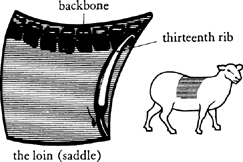Mastering the Art of French Cooking, Volume 2 (88 page)
Read Mastering the Art of French Cooking, Volume 2 Online
Authors: Julia Child

Other stuffings
Other
stuffing possibilities
are listed, and 6 stuffings specifically for lamb are in Volume I, pages 336–8.
BREAST OF LAMB
Poitrine d’ Agneau
Breast of lamb (the bottom of the rib cage, similar to that of
veal
) is the most reasonably priced of any cut of meat, and is delicious when boned, stuffed, and braised. However, it must be very carefully peeled, and all the fat from the plate must be cut out, as well as other extraneous fat. If you do find a well-trimmed breast, follow
the general system outlined for stuffed breast of veal
, using either that stuffing or any of the preceding suggestions for shoulder of lamb.
SADDLE OF LAMB
Selle d’ Agneau
A saddle of lamb is one of the most luxurious and attractive roasts you could pick to serve at a small, elegant dinner party for 4 to 6 people. When you have prepared it for the oven, which is not difficult as you will see from the illustrated directions, you will find it far easier to roast and to carve than a leg of lamb, and absolutely delicious to eat.
HOW TO ORDER A SADDLE OF LAMB
The saddle of lamb is the loin. On a beef carcass it would be the whole porterhouse and T-bone steak section on both sides, and on lamb it is the whole loin-chop area. It is, in fact, a giant butterfly loin chop 8 to 10 inches thick, consisting of the 2 meaty loin strips that run along either side of the backbone on top, and the 2 smaller tenderloin strips that run its length underneath. What would constitute the tail of the chop is the flank, or flap of meat attached to each side.
Because names of meat cuts vary from one part of the country to another, your butcher may understand the term “saddle” to mean the whole loin-hip-leg section of lamb, and he may only know what you mean when you ask him for the double kidney loin. Show him this picture if you have trouble communicating, or point the saddle out to him on yourself. It is equivalent to the small of your back on both sides of the backbone, and includes the front part of you; in other words, it is the whole area from the top of your hip bone to where your ribs begin. Tell him to leave it whole; he is not to saw it in two at the backbone. The choicest saddle will come from a carcass of spring lamb that weighs not more than 45 pounds; the saddle will weigh around 6½ pounds untrimmed, 3½ pounds ready to roast.
FRENCH TERMINOLOGY
You may also have communication problems in France, because the saddle can be called
selle d’agneau, selle anglaise
, or
les deux filets réunis
. Again, point it out on yourself if there is any confusion. Their saddle of lamb will be a little smaller than an American one, while a
selle de mouton
from their excellent mutton will be a little larger and should be well aged,
bien rassie
.
HOW TO PREPARE A SADDLE OF LAMB FOR ROASTING
This is the way the topside of the saddle will look before the flanks have been trimmed off. Ask that the fell (skin) be removed, which will leave a covering of fat over the top of the meat. Have the thirteenth rib removed also, if attached. |
|
| Remove all excess fat from the underside; this may include the kidneys. The strips of tenderloin meat run parallel to the backbone on either side, and parallel to their outside edge is a partially hidden strip of fat. |
Cut and pull fat out, being careful not to pierce the flanks and make holes in outside covering of meat. Cut off all but about 3 inches of flank, leaving enough on each side for flanks to cover the underside of the backbone.




